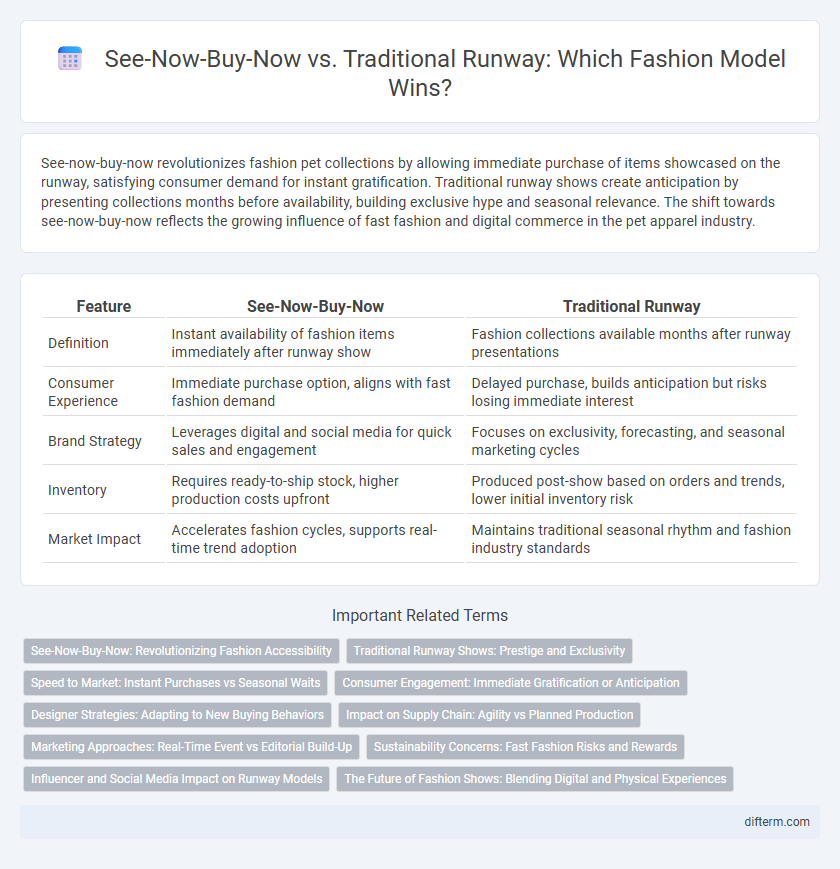See-now-buy-now revolutionizes fashion pet collections by allowing immediate purchase of items showcased on the runway, satisfying consumer demand for instant gratification. Traditional runway shows create anticipation by presenting collections months before availability, building exclusive hype and seasonal relevance. The shift towards see-now-buy-now reflects the growing influence of fast fashion and digital commerce in the pet apparel industry.
Table of Comparison
| Feature | See-Now-Buy-Now | Traditional Runway |
|---|---|---|
| Definition | Instant availability of fashion items immediately after runway show | Fashion collections available months after runway presentations |
| Consumer Experience | Immediate purchase option, aligns with fast fashion demand | Delayed purchase, builds anticipation but risks losing immediate interest |
| Brand Strategy | Leverages digital and social media for quick sales and engagement | Focuses on exclusivity, forecasting, and seasonal marketing cycles |
| Inventory | Requires ready-to-ship stock, higher production costs upfront | Produced post-show based on orders and trends, lower initial inventory risk |
| Market Impact | Accelerates fashion cycles, supports real-time trend adoption | Maintains traditional seasonal rhythm and fashion industry standards |
See-Now-Buy-Now: Revolutionizing Fashion Accessibility
See-Now-Buy-Now revolutionizes fashion accessibility by enabling consumers to purchase runway collections immediately after they debut, breaking the months-long wait typical of traditional runway shows. This strategy enhances consumer engagement and drives instant demand, aligning with fast-moving digital retail trends. Retailers and designers benefit from real-time sales data and reduced inventory risks, reshaping the fashion industry's supply chain and marketing dynamics.
Traditional Runway Shows: Prestige and Exclusivity
Traditional runway shows maintain their prestige by showcasing high fashion collections in exclusive settings, reinforcing brand identity and craftsmanship. These events create anticipation and desire through carefully curated presentations, often limiting immediate purchasing to heighten exclusivity. Luxury fashion houses leverage these shows to cultivate an elite image, differentiating themselves from the immediacy of see-now-buy-now models.
Speed to Market: Instant Purchases vs Seasonal Waits
See-now-buy-now revolutionizes fashion by enabling consumers to purchase collections immediately after the runway show, eliminating the months-long wait typical of traditional seasonal releases. This accelerated speed to market boosts sales potential and aligns with consumer demand for instant gratification. Traditional runway shows follow a delayed retail cycle, slowing inventory turnover and often risking trend obsolescence by the time products reach stores.
Consumer Engagement: Immediate Gratification or Anticipation
See-now-buy-now fashion shows drive heightened consumer engagement by offering immediate gratification, enabling shoppers to purchase items instantly after the runway presentation. This model leverages the instant availability of products to capitalize on consumer excitement and social media buzz, boosting sales and brand interaction. In contrast, traditional runway shows build anticipation through delayed release schedules, fostering prolonged interest and exclusivity but risking diminished engagement from impatient consumers.
Designer Strategies: Adapting to New Buying Behaviors
Designers embrace see-now-buy-now strategies to capitalize on instant consumer demand, accelerating revenue and enhancing real-time engagement. Traditional runway shows delay product availability, relying on seasonal anticipation and editorial influence to drive pre-orders and wholesale interest. Balancing immediate sales with long-term brand storytelling requires integrating digital platforms, agile production, and targeted marketing to align with evolving buyer preferences.
Impact on Supply Chain: Agility vs Planned Production
See-now-buy-now disrupts traditional runway schedules by demanding rapid supply chain agility to meet immediate consumer demand, accelerating inventory turnover and reducing lead times. Traditional runway relies on planned production cycles that optimize materials sourcing and manufacturing efficiency but risk overstock or stockouts due to forecast inaccuracies. Brands adopting see-now-buy-now leverage real-time data analytics and flexible manufacturing to enhance responsiveness, while traditional models prioritize economies of scale and long-term production planning.
Marketing Approaches: Real-Time Event vs Editorial Build-Up
See-now-buy-now leverages real-time event marketing to create immediate consumer engagement and capitalize on instant purchase impulses, driving higher conversion rates during the live runway show. Traditional runway shows rely on an editorial build-up marketing approach, generating anticipation through strategic media releases, influencer partnerships, and delayed retail availability to maximize fashion storytelling and seasonal collections. Brands adopting see-now-buy-now optimize digital platforms and social media for instant demand capture, while traditional approaches focus on curated magazine features and planned retail launches to sustain long-term brand equity.
Sustainability Concerns: Fast Fashion Risks and Rewards
See-now-buy-now models accelerate consumer access to collections, intensifying fast fashion production cycles that increase textile waste and carbon emissions. Traditional runway shows allow brands more time for sustainable sourcing and slower production schedules, reducing environmental impact. Balancing immediate consumer demand with ethical manufacturing remains a critical challenge in sustainable fashion innovation.
Influencer and Social Media Impact on Runway Models
Influencer and social media platforms have revolutionized the see-now-buy-now model by enabling immediate consumer access to runway collections, bypassing traditional seasonal delays. This instant visibility amplifies the roles of runway models as digital influencers, increasing direct engagement and driving real-time purchasing decisions. Traditional runway shows struggle to maintain this immediacy, as they rely on delayed market availability that limits social media momentum and influencer impact.
The Future of Fashion Shows: Blending Digital and Physical Experiences
The future of fashion shows integrates see-now-buy-now models with traditional runway formats, enhancing real-time consumer engagement and immediate purchasing opportunities. Digital platforms enable immersive virtual experiences, while physical shows maintain exclusive, tactile elements, creating a hybrid ecosystem. This convergence drives innovation in audience reach, brand connectivity, and sales conversion, reshaping industry standards.
see-now-buy-now vs traditional runway Infographic

 difterm.com
difterm.com